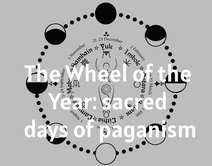Learn about The Wheel of the Year holidays and how they were celebrated in ancient times.
The Wheel of the Year is a cycle of seasonal festivals based on pre-Christian celebrations. In ancient times, there were four main High Days celebrated by Gaelic people: Samhain, Imbolc, Beltaine, and Lughnassadh. Yule or Winter Solstice and Ostara are from Germanic practices. Summer Solstice celebrations could be as old as the neolithic times, and Mabon was created in the 20th century by Aiden Kelly, an important neo pagan scholar. Some historians believe Beltaine and Samhain were considered the two most important Sabbats in ancient times. Join Mysticsense to learn the history of these days and how they symbolize the cycle of life, death, and rebirth.
Samhain- November 1
Samhain is the start of the winter half of the year and was originally celebrated in Ireland, Scotland, and the Isle of Man. It was a harvest celebration and a time to remember the dead. It is believed the veil that separates the land of the living from where the dead reside in the Otherworld is thinner, so the dead visit. Samhain is attested to in the Gaulish Coligny Calendar that dates back to the second century, and it was originally celebrated for three days.
It was the final harvest because weather turned harsh afterwards, and they harvested and stored the food beforehand. It was the time they took the animals from the grazing fields to the winter areas for shelter. Bonfires were lit to drive out bad spirits believed to cause death and disease, and people and animals were blessed. It was believed the dead and Sidhe carried the living back to the Otherworld with them. This was not seen as a good thing, so the people took measures to safeguard against it. They did not go out at night on Samhain unless they absolutely had to, and if they did, they turned their clothes inside out or carried a piece of iron for protection. People put out fires in their house Samhain and relit them from pieces of ceremonial bonfires. High Kings of Ireland sometimes had major gatherings every three or seven years and a huge festival.
Winter Solstice- December 21

The Winter Solstice, also called Midwinter, or Yule celebrated the shortest day and longest night had come and the days would begin to grow longer. Bonfires were lit, emulating the Sun’s power, and to also lend some heat to the strengthening Sun. January through April were lean months foodwise, called famine months. People were dependent on the Sun to make food grow. More people sickened and died in Winter months from starvation and illness, and the Winter Solstice offered hope these bad times were not going to last forever. The Sun was seen as being reborn.
Yule comes from the word, Jol from Jolnir which is a name for Odin. It was called YuleTide and celebrated November through January. At times it lasted three days. Hakon the Good ordered everybody to bring food and drink to the celebration and the festivities went on until everybody ran out of ale. People brought animals to be sacrificed at the temple, and the meat became the feast. The host led toasts, the first toast was drunk to Odin. The second toast to Njorder and Freyjr, and the third to the host. Some people celebrate twelve nights, with the final night being called Twelfth Night by staying awake all night and praying. Read more here: All About the Winter Solstice
Imbolc- February 1
Also called Oimelc, it means in the belly, and alludes to the milk the animals would be producing, as it was calf and ewe season. The earth, like a pregnant lady, was filled with life and would soon give birth to Spring. Signs of Spring have already begun at Imbolc. Birds that migrated have returned. The thawing of ice is beginning. Buds are on the trees. The goddess Brigid was venerated. She is shedding her other form, the winter hag, also called the Cailleach. The Cailleach strikes the ground with her staff, and that freezes the land at wintertime. Other myths say she washes her plaid in Corryvrecken Whirlpool until it is pure white, and that makes it winter. At Imbolc, Brigid is taking over.
People made a bed for Brigid and placed a Brigid’s Cross on their door to invite her into their homes. Food and drink was left for her, and clothes were left outdoors for her to bless. Weather divination is also done. It is said if Imbolc is sunny, the Cailleach makes the sun shine so she can gather firewood, and there will be six more weeks of winter. However, if the weather is grey, she overslept, and winter will break. Read more here: All About Imbolc
Ostara- March 21
This is said to be named after a goddess some say never existed, but Jacob Grimm and Bede say differently. She is a goddesss of Spring and Bede wrote that in Eostromap- or the month of April, Anglo-Saxon pagans had a celebration in her honor. Her celebrations were transferred over to Easter. In the 1800’s, Jacob Grimm wrote “ We Germans to this day call April ostermonat, and ôstarmânoth is found as early as Eginhart . The great Christian festival, which usually falls in April or the end of March, bears in the oldest of OHG remains the name ôstarâ ... it is mostly found in the plural, because two days ... were kept at Easter. This Ostarâ, like the [Anglo-Saxon] Eástre, must in heathen religion have denoted a higher being, whose worship was so firmly rooted, that the Christian teachers tolerated the name, and applied it to one of their own grandest anniversaries.”
“ Ostara, Eástre seems therefore to have been the divinity of the radiant dawn, of upspringing light, a spectacle that brings joy and blessing, whose meaning could be easily adapted by the resurrection-day of the Christian's God. Bonfires were lighted at Easter and according to popular belief of long standing, the moment the sun rises on Easter Sunday morning, he gives three joyful leaps, he dances for joy ... Water drawn on the Easter morning is, like that at Christmas, holy and healing ... here also heathen notions seems to have grafted themselves on great Christian festivals. Maidens clothed in white, who at Easter, at the season of returning spring, show themselves in clefts of the rock and on mountains, are suggestive of the ancient goddess.”
Ostara comes between Imbolc and Beltane and is celebrated on the Vernal Equinox. As to the Sun, daylight and night are balanced, and the days grow longer. New Life and growth are celebrated in various ways. Some celebrate the goddess’s fertility growing ever stronger and the father god is seen as growing towards manhood. It is said that painting eggs at Ostara predates modern times and that the hare has always symbolized fertility. Ways to celebrate include asking for the energy of the celebration to propel new things forward into our lives. Read more here: The Spring Equinox
Beltane- May 1

Beltane was traditionally the beginning of the Summer half of the year in the British Isles in ancient times. It is between Spring Equinox and Summer Solstice. It was a time when the animals were brought out to the Summer pastures. Two bonfires were blessed, and the people and animals walked between them to be cleansed of negative energies from Winter. They prayed for growth and productivity too. Fires in the house were put out, and new ones lit from the ceremonial fires. Rituals to protect and bless the people and livestock were done, and there was feasting.
Beltane was an opportunity for the people to ask the gods to make the growing season productive so the starvation months didn’t hit them hard. The fae, or Sidhe also were given gifts, and this was another time it was believed the veil between the worlds thinned. Instead of warding off the dead and Sidhe, they gave offerings to them. People and animals leapt over the flames for blessings. When the flames died down, rubbing ashes on the body for blessings, and sprinkling the ashes at your home or fields was done to protect and bless also.
The Maypole comes from the Germans. It was first recorded being used in the British Isles in the mid 1300’s. Germanics invaded the British Isles after Roman Colonization had ended. Today the Maypole symbolizes fertility. The Meaning of Beltane
Summer Solstice- June 21
Litha is when day is longest, night is shortest, and it celebrates the sun at the height of its power. Traditionally in the British Isles, bonfires burned day and night to give more power to the sun. Torchlight processions, to further give the sun power can be seen to this day. A modern story some Wiccans embrace tells of the Oak and Holly Kings. The Holly King rules over winter, and the Oak King rules over summer. At the Solstices, they battle. Summer Solstice, the Oak King, the youthful, physically powerful king overthrows the Holly King, who has become old and weak.
One place where over 20,000 people gather for Summer Solstice is Stonehenge. It was built in such a way that the sun rises over certain stones in the complex on specific days. One such sunrise is when the Midsummer, or Summer Solstice sun rises aligning with what is called The Heel Stone. We don’t know what was done all those years ago at Stonehenge for the Solstice, but it is believed it was sacred to them. The Summer Solstice is when the Sun is at the height of its power, and rituals give thanks and ask for it to continue- the harvest is not ready yet, and more power and heat is needed from the sun to make the food continue to grow.
It is believed this is a very old celebration that predates written records and unless more writings turn up, we may never know exactly what was done back in those days. We just know it was sacred enough they built places like Stonehenge that gives evidence it was very important. Work on Stonehenge started about 5,000 years ago and continued for about 1,000 years. Read more here: The Summer Solstice
Lughnasadh - August 1
Lughnasadh was originally celebrated in ancient Ireland, and spread to the Isle of Man and Wales. Situated between the Summer Solstice and Autumnal Equinox, it is included with Imbolc, Betaine, and Samhain as a seasonal celebration and coincides with Lammas, celebrated by Christians. Lammas celebrates a miraculous release of the apostle Peter from prison, and some bake bread with the first harvested wheat of the season to celebrate.
Lughnassadh saw a large sports event, festive market, and large gathering held in honor of the god Lugh’s foster-mother, Tailltiu. Legend has it that she died planting crops for the people when they had just moved into Ireland. This may have started as early as 632 BCE. Athletic competitions like running, archery, spear throwing, and high jump competitions were held, and crafts persons had competitions of their own, to see who was considered to be the best weavers, armorers, metalworkers, and jewelers. Most surprisingly, however, special trial marriages were arranged at Lughnasadh called “Taillten Marriages.”
The couples often met for the first time there, and had a one year trial marriage called a handfasting. At the following Lughnasadh, they could make their marriage permanent, or part ways. These marriages are documented as being done until the thirteenth century. Besides the marriages and crafts and athletic competitions, other important events were competitions for singing and storytelling, as well as dance. Legally binding agreements could be renewed, and new ones could be created at Lughnassadh time as well. Read more here: A Guide to Lughnasadh | What is Lughnasadh?
Mabon- September 21
This one is celebrated on the Autumnal Equinox and the name Mabon comes to us from Aidan Kelly. He could not really find a deity he felt reflected Autumnal Equinox except for the Welsh Mabon ap Modron. He said,
“ Archaeological and mythological evidence is that the fall equinox is an ancient ( at least 5k years) fest associated with death and rebirth of a young person (Kore, Issac) . Mabon is the only one I could find in the Northern myths.He is a minor character in an obscure tale in the Mabinogin…What myth about a child rescued from death might have been associated with the equinox in Northern cultures?” That’s how he chose Mabon. Mabon’s name comes from the god Maponos, which means “ great son.”
Myths say Mabon was born to Modron and was stolen from her three days after his birth but he was rescued by King Arthur and his men. It is believed both he and his mother were originally a mother/son goddess god pair. He could only be found once the oldest of the animals, a salmon was consulted. Then he eventually helped King Arthur and his men.
Mabon is celebrated at Autumnal Equinox. Day and night are equal. After this the days grow ever shorter, the nights longer, as we approach Samhain once again. The sun god dies and will be reborn at Winter Solstice. Some people take stock of what they have harvested, or accomplished and they give thanks. Read more here: The Fall Equinox | History & Traditions
As the Wheel of the Year turns, the people who celebrate them blend with the seasons and apply the blessings of the Sabbats to their own lives. As the seasons change, may you reap the blessings they offer and may the spirit of the earth bless you. So Be It.
We have selected the most relevant psychics for this article, you can connect with any of them and get accurate advice on this subject.









